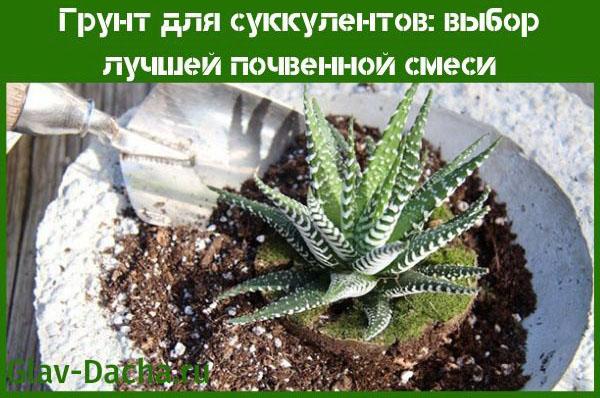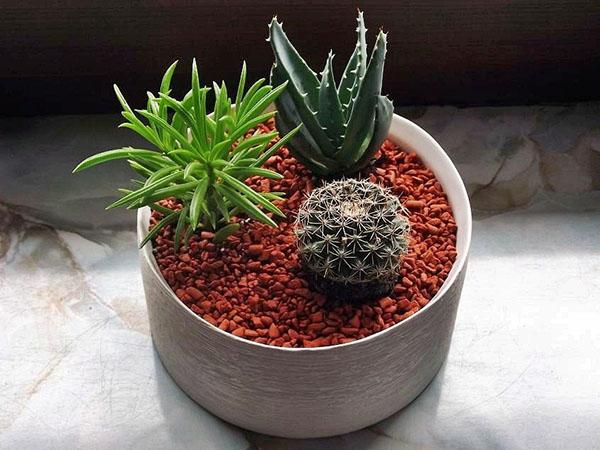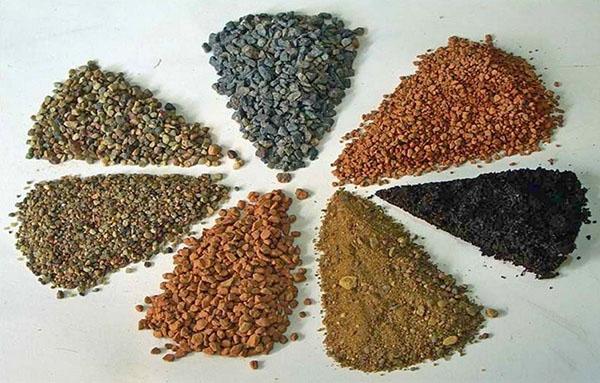Soil for succulents: choosing the best potting mix
 Soil for succulents can be prepared with your own hands at home. It is based on components that help the plant retain the necessary nutrients and moisture.
Soil for succulents can be prepared with your own hands at home. It is based on components that help the plant retain the necessary nutrients and moisture.
Soil in natural habitat

Such conditions of existence in the natural environment led to the fact that succulents adapted to harsh circumstances. Their roots quickly absorb maximum moisture, and the aerial part retains it for as long as possible - for weeks.
Taking into account the conditions that are natural for succulents, you cannot use ordinary universal potting mixes to grow them.
What is the soil for succulents
 Succulents are slow growing. Most of them add no more than 10 mm per year. Their roots are usually small, and the leaves and stems are dense enough to retain a lot of moisture.
Succulents are slow growing. Most of them add no more than 10 mm per year. Their roots are usually small, and the leaves and stems are dense enough to retain a lot of moisture.
What can and should be added to the soil

When composing soil for succulents, it is necessary to take into account the following requirements:
- good drainage;
- high aeration;
- fast drying;
- porosity and looseness;
- dry top layer.
The composition of the soil for indoor succulent should include several layers:
|
Layer by location |
Characteristic | Note |
| Lower | This layer should provide good drainage. Small expanded clay is used to create it. | Instead of expanded clay, it is possible to use small pebbles or broken brick |
| Middle | For cooking, several ingredients are used in the required proportion.
The approximate composition of the soil for succulents:
This layer should not reach the very top of the pot by 10-20 mm |
Some small stones can be added to the potting mix |
| Upper | For the topmost layer, it is recommended to choose perlite or expanded clay.
The layer should be 10-15 mm thick |
This is an optional but desirable layer. |
Since brick is inherently fired clay, adding it to the soil for succulents has the benefit of removing excess moisture from the ground. It is recommended to add crushed charcoal to almost all mixtures for planting so that it makes up about a tenth of the total volume of prepared soil.
All potting soil ingredients prepared for the succulent must be pre-disinfected. Without such additional treatment, there is a possibility of introducing pathogens.
To do this, carry out the following drainage work:
- the prepared material is washed;
- keep for several hours in a weak solution of potassium permanganate;
- dried in the oven.
The earth and sand, which will be used as soil for succulents, are also processed: they are calcined in the oven for at least an hour.
Before transplanting, the succulent should not be watered for several days, and after being placed in a new potting mix, it is also advisable to refrain from watering for several days.
What should not be added to the soil and why
 Not all types of succulents respond equally to the occurrence of some components. But it's best to play it safe and use some simple general recommendations.
Not all types of succulents respond equally to the occurrence of some components. But it's best to play it safe and use some simple general recommendations.
The benefits and harms of peat
When choosing purchased soil for succulents, you should study its composition. You can not use a mixture that contains a lot of peat, and even more so, it consists entirely of it. This can provoke root rot, since peat has the ability to accumulate moisture.
You can compensate for peat, which tends to cake and retain water, by adding a large amount of sand or crushed expanded clay to the soil mixture.
Soil acidity
The preferred soil for all succulents without exception is pH neutral. But there are also exceptions. For example, for aloe and cactus this indicator is not decisive.
When organic is harmful
 Organic fertilizers contain a lot of nitrogen. This can lead to oversaturation and, as a consequence, accelerated growth. At the same time, the succulent loses the elasticity of the trunk and leaves, which crack and become lethargic. The plant begins to ache and lose its decorative appearance.
Organic fertilizers contain a lot of nitrogen. This can lead to oversaturation and, as a consequence, accelerated growth. At the same time, the succulent loses the elasticity of the trunk and leaves, which crack and become lethargic. The plant begins to ache and lose its decorative appearance.
Properly prepared soil for succulents with your own hands is one of the most important points when growing such plants. Taking into account the recommendations, and taking preventive measures, you can grow ornamental plants at home that will delight with their laconic beauty for many years.